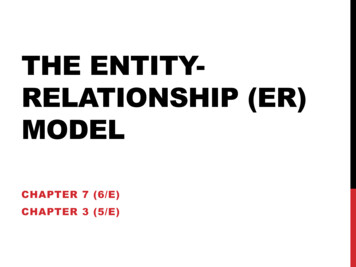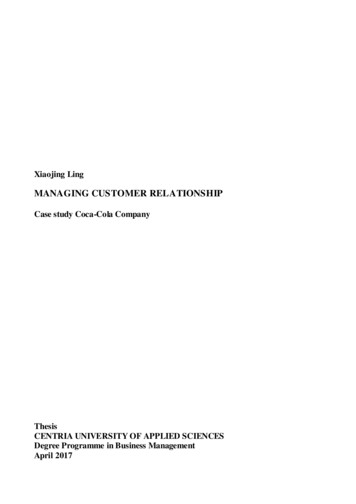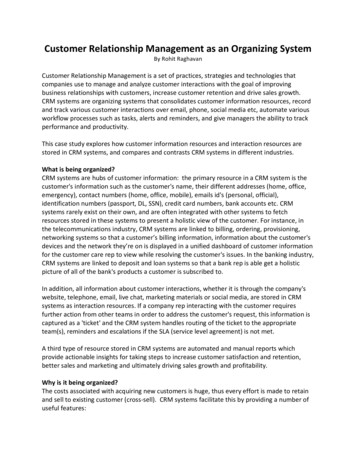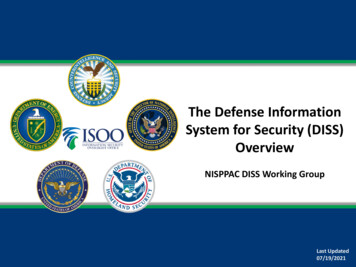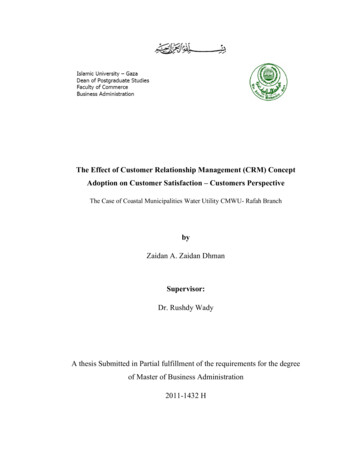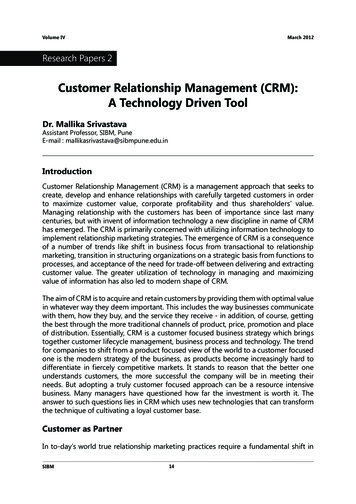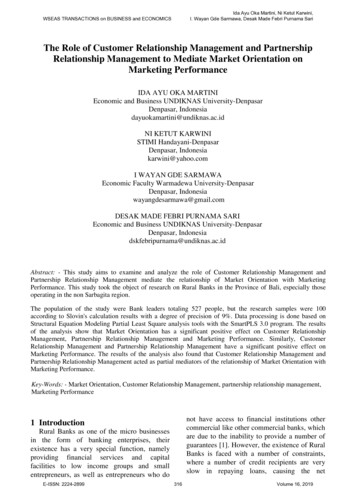
Transcription
Ida Ayu Oka Martini, Ni Ketut Karwini,I. Wayan Gde Sarmawa, Desak Made Febri Purnama SariWSEAS TRANSACTIONS on BUSINESS and ECONOMICSThe Role of Customer Relationship Management and PartnershipRelationship Management to Mediate Market Orientation onMarketing PerformanceIDA AYU OKA MARTINIEconomic and Business UNDIKNAS University-DenpasarDenpasar, Indonesiadayuokamartini@undiknas.ac.idNI KETUT KARWINISTIMI Handayani-DenpasarDenpasar, Indonesiakarwini@yahoo.comI WAYAN GDE SARMAWAEconomic Faculty Warmadewa University-DenpasarDenpasar, Indonesiawayangdesarmawa@gmail.comDESAK MADE FEBRI PURNAMA SARIEconomic and Business UNDIKNAS University-DenpasarDenpasar, Indonesiadskfebripurnama@undiknas.ac.idAbstract: - This study aims to examine and analyze the role of Customer Relationship Management andPartnership Relationship Management mediate the relationship of Market Orientation with MarketingPerformance. This study took the object of research on Rural Banks in the Province of Bali, especially thoseoperating in the non Sarbagita region.The population of the study were Bank leaders totaling 527 people, but the research samples were 100according to Slovin's calculation results with a degree of precision of 9%. Data processing is done based onStructural Equation Modeling Partial Least Square analysis tools with the SmartPLS 3.0 program. The resultsof the analysis show that Market Orientation has a significant positive effect on Customer RelationshipManagement, Partnership Relationship Management and Marketing Performance. Similarly, CustomerRelationship Management and Partnership Relationship Management have a significant positive effect onMarketing Performance. The results of the analysis also found that Customer Relationship Management andPartnership Relationship Management acted as partial mediators of the relationship of Market Orientation withMarketing Performance.Key-Words: - Market Orientation, Customer Relationship Management, partnership relationship management,Marketing Performancenot have access to financial institutions othercommercial like other commercial banks, whichare due to the inability to provide a number ofguarantees [1]. However, the existence of RuralBanks is faced with a number of constraints,where a number of credit recipients are veryslow in repaying loans, causing the net1 IntroductionRural Banks as one of the micro businessesin the form of banking enterprises, theirexistence has a very special function, namelyproviding financial services and capitalfacilities to low income groups and smallentrepreneurs, as well as entrepreneurs who doE-ISSN: 2224-2899316Volume 16, 2019
Ida Ayu Oka Martini, Ni Ketut Karwini,I. Wayan Gde Sarmawa, Desak Made Febri Purnama SariWSEAS TRANSACTIONS on BUSINESS and ECONOMICSperforming loan (NPL) or delinquent customerloans of a number of Rural Banks to be high.This is also the reason for a number of ruralbanks becoming less healthy in terms of NPL.This is especially true for rural banks in thenon-Sarbagita region of Bali Province.Judging from the credit MarketingPerformance, it shows that Rural Banks in nonSarbagita regions have a more volatilemarketing credit performance and tend todecline compared to Rural Banks in theSarbagita region. This is shown in the followingdiagram:on the target of Marketing Performance as atarget for the Market Orientation strategy. [4],also wrote that with a survey conducted oncompanies in Nigeria, that Market Orientationwould be able to encourage increasedMarketing Performance. Companies that canimprove the attitude of the Market Orientationas an internal behavior of resources, will beable to improve the Marketing Performance ofthe company. Market Orientation willencourage increased profitability [5]. Increasedprofitability shows good corporate earningsperformance, and good market shareperformance. Profit performance and marketperformance are part of the company'smarketing behavior. Market Orientation is theattitude and behavior of the company's internalresources that are responsive to customer needsboth for current conditions and on customerneeds in the future, thus reflecting the ability ofthe company's resources in presenting customerneeds beyond the capabilities that can bepresented by competing companies in marketsthat same [12]A number of studies on Market Orientationwith a combination of mapping in differentorientations have been conducted in a numberof countries, including. [11] His research on anumber of companies in Germany, proves thatMarket Orientation is a determinant and buildsa Market Orientation strategy on national transcompanies that have businesses in manycountries. [13], conducted a study of 73companies engaged in the textile and garmentindustry in Hong Kong, based on the theoreticalframework developed by [2] proving that theMarket Orientation pattern of companies inHong Kong is not much different from thepattern of Market Orientation obtained indeveloped countries is that the pattern ofMarket Orientation functions very significantlyin determining Marketing Performance. [14],conducted a study of 162 samples ofmanufacturing and service companies in theIndian region, proving that Market Orientationhas succeeded in increasing the growth ofoperating profit and accumulated companyprofits. A number of research findings alsofound that Market Orientations affect CustomerRelationship Management [15] and PartnershipRelationship Management [16].Based on Table 1, it is clear that the nonSarbagita BPR credit marketing performancetends to experience a sharp decline.According to a number of experts andsupported by research results, marketingperformance can be influenced by a number ershipRelationship Management [10].2.Theoretical,HypothesisEmpirical,and2.1. Market OrientationMarket Orientation is the company's abilityto direct the company's marketing strategy tocontinuously adapt to market changes and thebusiness environment [11]. Market Orientationis developed in order to create added value forcustomers. Survey results on a number ofcompanies in Thailand about MarketOrientation which have important implicationsin building and improving MarketingPerformance [2]. This is empirical evidenceabout Market Orientation that is more focusedE-ISSN: 2224-2899317Volume 16, 2019
Ida Ayu Oka Martini, Ni Ketut Karwini,I. Wayan Gde Sarmawa, Desak Made Febri Purnama SariWSEAS TRANSACTIONS on BUSINESS and ECONOMICSBangalore, showed that there were significantpositive effects between Market Orientation onMarketing Performance. Research by [20],conducted at micro-finance companies in Kenyashowed that there was a significant influencebetween Market Orientation towards MarketingPerformance. The research conducted by [21],at MSMs Batik in Sragen found that MarketOrientation showed a significant positiveinfluence on the company's MarketingPerformance. [22], in his research on silver craftSMEs found that Market Orientation alsoshowed a significant positive effect onMarketing Performance.Hypothesis 1: Market Orientation has apositive effect on CustomerRelationship ManagementHypothesis 2: Market Orientation has apositive effect significantly onPartnershipRelationshipManagementHypothesis 3: Market Orientation has asignificant positive effect onMarketing Performance2.2. Customer Relationship ManagementMarketing Performance is the result of theachievement of company activities in providinggoods and services. The company's activities ingenerating added value for customers are calledMarketing Performance, while the productsproduced are the end result of the businessactivities concerned. When many companieshave to face competitors in getting the marketfor products that are produced by the company,then service to consumers and maintainingcustomer satisfaction on an ongoing basis is aprocess that will stabilize company profits. [17]stated that in producing competitive businessproducts, efforts to integrate a number ofresources include collaborative resources,management control and employee careerdevelopment as an important part in maintainingthe company's service focus to customers. Thegoal achieved from each step of developing astrategy focused on marketing is that thecompany can always display and providequality service to customers in order to increasemarket share.In order to build Marketing Performance, thechallenges of the business environment in thefuture will always be faced with increasingcompetitor capabilities that will threaten marketsegments that have been achieved by thecompany (market turbulence), competitors inincreasingly technological innovation and theintensity of business competition. strict ingetting the company's market segment.Previous research found that there was asignificant positive effect between MarketOrientation on Marketing Performance, asresearch by [18], research on 165 small andmedium-sized industrial companies conductedin Ghana showed a significant positive effectbetween Market Orientation on MarketingPerformance. Research by [19], conducted insmall and medium-sized companies inE-ISSN: 2224-2899Hypothesis 4: CustomerRelationshipManagement has a significantpositive effect on MarketingPerformance2.3. Partnership Relationship ManagementPartnershipRelationshipManagement(PRM) is a partnership strategy in order to buildcollaboration and equality in maintainingnetworks and strengthening market networks. Inorder to realize PRM-based marketingstrategies, link development, coordinating andsharing information between companies areestablished between companies that worktogether / partnership [23]. The PRM system isthe development of partnership capabilities inan effort to reduce the marketing cost burdenand mitigate opportunities for strengtheningmarket segments in order to monitor customerdynamics [24]. Thus, it can be stated that PRMis a strategy used in maximizing collaborationopportunities to obtain company profits.[25] conducted research on this PRM, obtainedthe results of research that the cooperativerelationship between the company itself and thecompeting company in acquiring customers hada significant effect on Marketing Performance.That there is a direct relationship between thebusiness partners, and customer satisfaction andwill ultimately have a positive impact on theprofitability of the company that supports theimprovement of Marketing Performance.Hypothesis 5: PartnershipRelationshipManagement has a significantpositive effect on MarketingPerformance318Volume 16, 2019
Ida Ayu Oka Martini, Ni Ketut Karwini,I. Wayan Gde Sarmawa, Desak Made Febri Purnama SariWSEAS TRANSACTIONS on BUSINESS and ECONOMICSTable 1Composite Reliability and Cronbach's ypothesis 6: CustomerRelationshipManagement acts as a mediatorof the relationship of s 7: PartnershipRelationshipManagement acts as a mediatorof the relationship of 9MO0,9340,943MP0,8490,886PRM0,9160,940Source: data processed, 2019.4.2. Structural Model EvaluationEvaluation of structural models is based onthe value of R Square (R2), Q Square PredictiveRelevance (Q2), and Goodness of Fit (GoF).Based on the results of the analysis, the R2value of the relationship between MarketOrientation (MO) and Customer RelationshipManagement (CRM) is 0.628. The relationshipbetween Market Orientation (MO) andPartnership Relationship Management (PRM) is0.094. Furthermore, the relationship of MarketOrientation (MO) with Marketing Performance(MP) of 0.697.The results of the Q2 calculation indicatethat the model has a very good level ofpredictive ability, which is equal to 89.79%.This is indicated by the value of Q2 obtainedthrough the following formula:3. Research MethodologyThe population of this study was the RuralBanks employees of Bali Province in the nonSarbagita area, which numbered 537 spreadacross 35 Rural Banks. Sampling is based onthe Slovin formula with a precision level of 9%,so the sample size is 100 employees. Themethod of determining the number ofrespondents in each Rural Banks is carried outin proportional random sampling.Data collection is done through distributingquestionnaires to each respondent who becamethe study sample. Furthermore, the method ofdata analysis is done by SEM-PLS with theSmartPLS 3.0 program through 3 stages,namely:: measurement model evaluation,structural model evaluation, and hypothesistesting. Evaluation of measurement modelsincludes convergent validity and discriminantvalidity, while structural model evaluationsinclude R-Square (R2), Q-Square (Q2), andGodness of Fit (GoF).4. Results And Discussion4.1. Evaluation of the Measurement ModelEvaluation of measurement models is shownthrough convergent validity, discriminantvalidity, composite reliability, and cronbach'salpha. The results of convergent validityevaluation are based on the outer loading valueof each indicator which is between 0.577-0.919.Discriminant validity is shown through the rootAVE which is greater than the correlation valuebetween other variables. The reliabilitycomposite values and Cronbach's Alpha areshown in Table 1.Table 1 shows the reliability composite valueand cronbach's alpha greater than 0.7. Based onthis, all variables are declared reliable. The testresults of the measurement model show that allindicators and variables in the research modelare valid and reliableE-ISSN: 2224-2899CRMCalculation of model accuracy is measuredthrough the Goodness of Fit (GoF), through thefollowing formula:The calculation results show that the model hasa good level of accuracy that is 0.5346.4.3. Hypothesis testingThe research hypothesis testing is based onthe results of the SmartPLS analysis shown inFigure 2, Table 2, and Table 3319Volume 16, 2019
Ida Ayu Oka Martini, Ni Ketut Karwini,I. Wayan Gde Sarmawa, Desak Made Febri Purnama SariWSEAS TRANSACTIONS on BUSINESS and ECONOMICSTable 3Path Coefficient Indirect Effects Between Market OrientationVariables on Marketing Performance through CustomerRelationship Management and Partnership RelationshipManagementCorrelation betweenvariablesPathCoefficientP ValuesInformationMO - CRM - MP0,1700,042H7 AcceptedMO - PRM - MP0,1860,011H8 AcceptedSource: data processed, 20195. ConclusionBased on the results of hypothesis testing theeffect of Market Orientation (MO), CustomerRelationship Management (CRM), PartnershipRelationship Management (PRM), and MarketPerformance (MP), it can be concluded that:1. Market Orientation (MO) has a significantpositive effect on Customer p Management (PRM), andMarket Performance (MP). That is, anincrease in market orientation can ce (MP) in Rural Banks in thenon Sarbagita region.2. CustomerRelationshipManagement(CRM), and Partnership RelationshipManagement(PRM),arepartiallymediating relationships between MarketOrientation(MO)andMarketingPerfomance (MP). That is, CustomerRelationship Management (CRM), andPartnership Relationship Management(PRM) are able to become intermediaries inthe relationship of market orientation withmarketing performance.--------------------Figure 2. Results of SmartPLS Analysis of the Relationshipbetween Market Orientation Variables, Customer RelationshipManagement, Partnership Relationship Management, andMarketing Performance.Table 2Path Coefficients Direct Effects Between Market OrientationVariables, Customer Relationship Management, PartnershipRelationship Management, and Marketing PerformanceCorrelationbetweenvariablesMO - CRMPathCoefficientP ValuesInformation0,7920,000H1 AcceptedMO - PRM0,3070,015H2 AcceptedMO - MP0,2190,039H3 AcceptedCRM - MP0,2140,033H4 AcceptedPRM - MP0,6040,000H5 AcceptedSource: data processed, 2019Table 2 shows that Market Orientation (MO)has a significant positive effect on CustomerRelationship Management (CRM), PartnershipRelationship Management (PRM), and ssignificantly nt(CRM),andPartnershipRelationship Management (PRM). Based on thedata, all the direct influence hypotheses (H1.H2, H3, H4, and H5) are accepted.References:[1] Laksito, H. dan Sutapa. 2007. MemprediksiKesehatan Bank dengan Rasio CAMELS padaBank Perkreditan Rakyat. Jurnal Keuangan danPerbankan. Vol. 14, No.1, pp.156 – 167.[2] Naver, John C., dan Stanley F. Slater, 2000,The positive Effect of a Market Orientation onBusiness Profitability: A Balanced Replication,Journal of Business Research, Vol. 48, pp. 69 –73[3] Zebal, Mostaque Ahmed, 2008, A SynthesisModel of Market Orientation For A DevelopingCountry-The Case of Bangladesh, Thesis,Victoria University of Technology Melbourne,Australia.Based on Table 3, it appears that CRM andPRM are partially mediating relationshipsbetween Market Orientation (MO) andMarketing Perfomance. These results indicatethat the hypothesis of indirect effects (H6 andH7) is accepted.E-ISSN: 2224-2899320Volume 16, 2019
Ida Ayu Oka Martini, Ni Ketut Karwini,I. Wayan Gde Sarmawa, Desak Made Febri Purnama SariWSEAS TRANSACTIONS on BUSINESS and ECONOMICSManagement: A Framework and Implicationfor Service Providers, Journal of ServiceMarketing, Vol. 20, No. 1, pp. 12 – 23[16] Soehadi Agus W., 2013, The ership, and Firm Performance in a retailcontext, Conference Proceeding Adelaide,pp.1041- 1046[17] Corbett A.A., and Hmieleski, K, M., 2005.Proclivity for Improvisation as a Predictor ofEntrepreneurial Intentions. Journal of SmallBusiness Management, Vol. 44, pp. 45-63[18] Mahmoud A.A., 2011, Market Orientation andBusiness Performance among SMEs in Ghana,International Business Research, Vol. 4, No. 1,pp.241-251[19] Ramesh R.S., 2014, Impact of MarketOrientation on SMEs Business Performance anEmpirical Study of Select SMEs in Bangalore,Acme Intellect International of Research inManagement, Social science & Technology,Vol. 8, No. 8, pp 1-13[20] Joseph O. and Francis K., 2015, The Influenceof Culture and Market Orientation onPerformance of Micro Finance Institution inKenya, International Journal and Management,Vol. 10, No.8, pp. 204-221.[21] Fatonah S., 2017. The impact of MarketOrientation and marketing strategies onperformance of SMES in Batik industry,International Journal of Civil Engineering andTechnology, Vol. 8, No, 8, pp. 1290-1298[22] Yuniari W., Kerti Yasa N., Giantari I.G.A.K.,2018. The role of competitive advantage inmediating the influence of Market rmance: a study on silver craft SMES inCeluk Village, Bali Province, European Journalof Business and Social Science, Vol. 6, No. 10,pp. 55-71[23] Lee, P. R., Naylor, G., Chen, Q. 2011. Linkingcustomer resources to firm success: The role ofmarketing program implementation. Journal ofBusiness Research, Vol. 64, pp. 394–400[24] Wang and Wei, 2007, Lai, Kin Keung, Yu,Lean, Wang, Shouyang, Huang, Wei. 2007.Hybridizing Exponential Smoothing and NeuralNetwork for Financial time series prediction,Foreign exchange rate forecasting withartificial neural network, Vol.15, pp.21-30[25] Shaheen and Iqra, 2015, A Review OfCustomer Satisfaction, And Their Impact OnFirm Performance International, Journal OfManagement & Organization Studies, Vol. 4,No. 1, March 2015, pp 34 – 38[4] Keskin, Halit, 2011, Market ilities in SMEs an Extended Model,European Journal of Innovation Management,Vol 9, No 4, pp. 201-216[5] Riza Casidy M, 2010, Riza CasidyMulyanegara, Yelena Tsarenko, (2010)Predicting brand preferences: An examinationof the predictive power of consumer personalityand values in the Australian fashion market,Journal of Fashion Marketing and Management,Vol. 13 Iss: 3, pp.358 – 371[6] Shehu A.M. Mahmood R, 2014, MarketOrientation and Firm Performance AmongNigerian SMEs: The Moderating Role ofBusiness Environment, Mediterranean Journalof Social Science, Vol. 5, No. 23, pp158-164[7] Reimann M., Schilke, O., Thomas J.S., 2009.Customer Relationship Management and FirmPerformance: the mediating role of businessstrategy, Journal of the Academy of MarketingScience, Vol. 38, No. 3, pp. 326-346[8] Namjoyan M., Esfahani A.N., Haery F.A.,2013. Studying the effects of customerrelationship management on the marketingperformance (Isfahan Saderat Bank as a casestudy), International Journal of AcademicResearch in Business and Social Sciences, Vol.3, No. 9, pp. 302-314[9] Nwokah N.G., Didia, J.U.D, 2015. Customerrelationship management and marketingperformance: the study of food and beveragesfirms in Nigeria, European Journal of Businessand Management, Vol. 7, No. 15, pp. 85-95[10] Shaheen and Iqra, 2015, A Review OfCustomer Satisfaction, And Their Impact OnFirm Performance International, Journal OfManagement & Organization Studies, Vol. 4,No. 1, March 2015, pp 34 – 38[11] Kanagal N.B., 2017. Development of marketorientation for marketing strategy formulation,International Journal of Marketing Studies, Vol.9, No. 4, pp. 54-65[12] Castro, Carmen Barroso, Enrique Marti’nArmario and Mari’a Elena Sa’nchez Del Rio,2005. Consequences of Market Orientation forCustomer and Employees, European Journal ofMarketing, Vol. 39, No. 5/6, pp. 646 – 675.[13] Chan (2003) Relationship Marketing: InovasiMarketing Yang Membuat Pelanggan BertekukLutut, PT. Gramedia Pustaka Utama, Jakarta.[14] Subramanian, M., and Youndt, M.,A., 2005,The Influence of Intellectual Capital on TheTypes of Innovative Capabilities, Academy ofManagement Journal, Vol. 48, pp. 3, pp. 450463[15] Javalgi G., 2006, Marketing Research, MarketOrientation and Customer RelationshipE-ISSN: 2224-2899321Volume 16, 2019
Similarly, Customer Relationship Management and Partnership Relationship Management have a significant positive effect on Marketing Performance. The results of the analysis also found that Customer Relationship Management and Partnership Relationship Management acted as partial mediators of the



